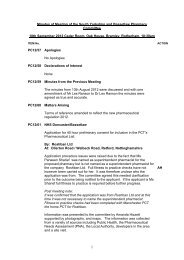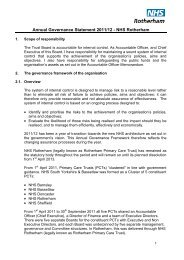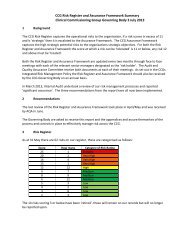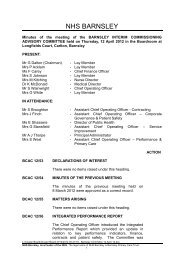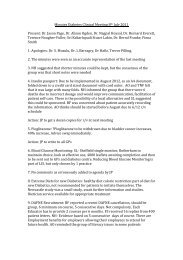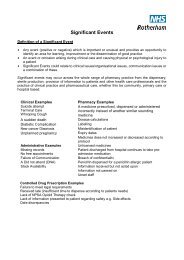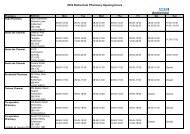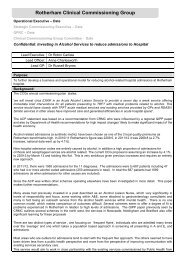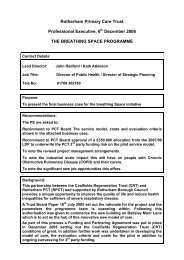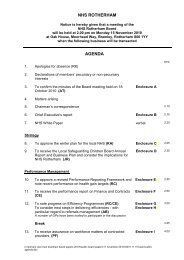Patient Group Direction (PGD) for - NHS Rotherham
Patient Group Direction (PGD) for - NHS Rotherham
Patient Group Direction (PGD) for - NHS Rotherham
You also want an ePaper? Increase the reach of your titles
YUMPU automatically turns print PDFs into web optimized ePapers that Google loves.
This document expires on 20.3.15<br />
<strong>Patient</strong> <strong>Group</strong> <strong>Direction</strong> No VI 4<br />
Action if Parent/Legal<br />
Guardian declines<br />
Treatment<br />
Notes <strong>for</strong> doctors /<br />
drug interactions<br />
Advice about protective effects of the vaccine and the risks of<br />
infection and disease complications.<br />
Document advice given in patients notes<br />
In<strong>for</strong>m or refer to GP as appropriate.<br />
Notify Child Health.<br />
Minor illnesses without fever or systemic upset are not valid<br />
reasons to postpone immunisation. If an individual is acutely<br />
unwell, immunisation may be postponed until they have fully<br />
recovered. This is to avoid confusing the differential diagnosis of<br />
any acute illness by wrongly attributing any signs or<br />
symptoms to the adverse effects of the vaccine.<br />
Individuals with immunosuppression or with HIV infection<br />
(regardless of CD4 counts) should be considered <strong>for</strong> diphtheriacontaining<br />
vaccines in accordance with the recommendations<br />
above. However, these individuals may not develop a full antibody<br />
response if they are immunosuppressed, and vaccine protective<br />
efficacy has not been studied. Re-immunisation should be<br />
considered after treatment is finished and recovery has occurred.<br />
Specialist advice may be required.<br />
2. Description of treatment<br />
DTaP/IPV/Hib vaccine can be given at the same time as other<br />
vaccines including MenC vaccine but at a different injection site –<br />
either in different limbs or at least 2.5cms from the concomitant<br />
immunisation.<br />
DTaP/IPV/Hib vaccine is compatible with previously administered<br />
DTwP-Hib and oral polio vaccines.<br />
DTaP/IPVHib vaccine should only be used as a primary course or<br />
to complete a primary course in children aged from 2 months and<br />
under 10 years of age.<br />
Drug Name: Combined Diphtheria, Tetanus, acellular Pertussis, Inactivated Polio Vaccine and Hib<br />
(DTaP/IPV/Hib -Pediacel®)<br />
Adsorbed diphtheria, tetanus, acellular pertussis, Inactivated Polio Viruses and<br />
Name, strength & Hib vaccine (DTaP/IPV/Hib - Pediacel®) is in the <strong>for</strong>m of a sterile liquid<br />
<strong>for</strong>mulation of drug suspension supplied in a single dose (0.5 ml) vial with an elastomer (latex free)<br />
stopper.<br />
Legal status<br />
POM (Prescription Only Medicine)<br />
Storage<br />
Dose<br />
Route/ method<br />
0.5ml<br />
Vaccines must be stored, transported and disposed according to<br />
manufacturers and the Department of Health guidelines and current<br />
legislation.<br />
Children over one year-IM injection into the deltoid.<br />
Infants under one year-IM injection into the anterolateral thigh.<br />
Bleeding disorders-deep subcutaneous injection.<br />
The site at which the vaccine was given should be noted in the individual‟s<br />
records.<br />
This <strong>Patient</strong> <strong>Group</strong> <strong>Direction</strong> is operational from 20.3.13 and will be reviewed every 2 years or in the light of<br />
new national guidance.<br />
Page 3 of 9



